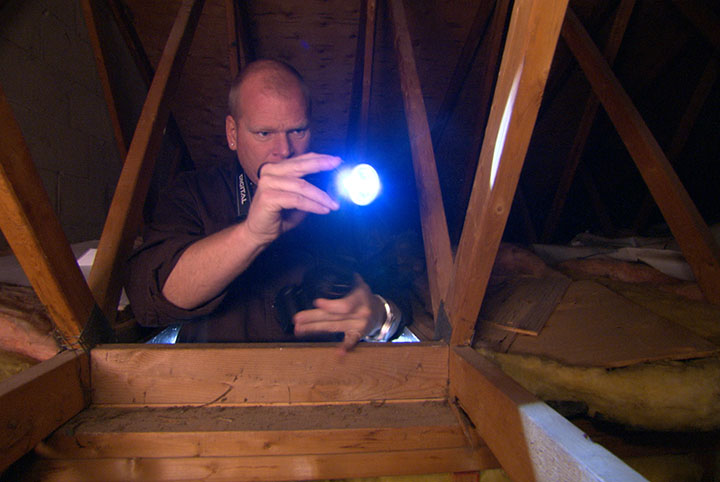
Your attic is an unconditioned area, which means that it should be similar to the same temperature and humidity as the outside air. It is also crucial that your attic is 1. properly ventilated and 2. insulated. If there is inadequate ventilation or insulation, you’re looking at plenty of issues with your attic and roof that can range from mould, rot ice damming, and more.

Image courtesy of The Holmes Group
Proper Ventilation
Proper ventilation is key to protecting your roof and attic space. We are constantly producing moisture in our homes; doing laundry, showering, cooking, doing dishes and even breathing are all things that produce moisture. That moisture needs to escape, or it could lead to mould growth or rot on materials like wood framing, and drywall.
Poor ventilation can also wear down your roof prematurely, causing shingles to blister due to too much of a heat build-up in the attic. The wood sheathing on your roof (under your shingles) can rot or become dry and brittle. This will result in having to replace the sheathing and shingles, which can more than double the cost of a roof replacement.
Poor ventilation in bathrooms and kitchen fans can contribute to humidity in your attic. It’s important to have extraction fans in these areas to pull the moisture from inside and push it out. The fans should be vented directly to the exterior to prevent warm, moist air from rising up to the attic.
How Many Vents Are Enough?
The number of vents in your roof will depend on the size of your attic. The standard is one square foot of venting for every 150 square feet, distributed evenly between the soffit and roof vents.
There are different kinds of vents:
- soffit vents (the narrow horizontal section on the underside of your roof eaves)
- gable vents (located on the top of the wall on either side of a peaked roof)
- box-style vents (square-shape with the open side facing the ground)
- ridge vents (they run along the peak of a roof to allow for continuous airflow)
Even though ridge vents are more expensive and labour-intensive, ridge vents are my preference. If you’re unsure as to whether your roof has enough ventilation, contact a professional roofer to take a look.

Image courtesy of The Holmes Group
Moisture and Mould
Too much moisture in your home can lead to mould in your attic, or anywhere in your home. There may be signs of moisture on walls, on the ceiling, in corners and around windows. You can use a moisture meter, but if your home is showing signs of moisture issues, it’s best to call in a professional to look for potential moisture issues around your home and test for air quality.
If mould is detected, you will need to deal with the moisture issue first before tackling the mould. If the area affected by mould exceeds a surface area of 10 square feet, you will need to call in the pros. A mould remediation company must professionally clean it. If the affected area is minor, you can probably handle the clean-up yourself, but be smart about it. Use proper products that help to remove and kill the mould. Never use bleach to clean mould; it’s a great surface cleaner, but without taking care of the spores, the mould is sure to grow back. Do it right and find a mould abatement product like Concrobium that will actually kill the mould below the surface, thus preventing regrowth and stopping spores from becoming airborne.
Proper Insulation
Proper insulation is important for having a comfortable, healthy home. Not only does insulation keep your home warm in the winter and cool in the summer, but it also helps to lower energy costs, prevents mould and can keep unwanted noise out. According to CMHC, cold floors and walls in the winter are signs that you have a poorly insulated home. Take a look at your roof after a snow fall. Is the snow melting in patches? This is a sign that heated air is escaping into your attic due to inadequate insulation. Once the snow melts, it will refreeze down by the gutters, causing icicles and ice damming – something you don’t want to see on your roof!
How Insulation is Rated
Insulation is rated based on the measurement of resistance the material has to the movement of heat, known at the R-value. The higher the R-value, the greater the effectiveness of the insulation. Local building codes list required R-values for each area of your home. Improper installation of insulation can affect the R-value of the material, so it’s a good idea to closely follow the manufacturer’s instructions, or hire a professional to make it right.
Different Types of Insulation
There are many different types of insulation, and the type you use will depend on the R-value that’s required or the area in which you’re looking to use it. When I’m insulating an attic, I go for an R-value of at least 60. That will help keep the house warm in the winter, but cool in the summer months.
Batt Insulation
Batt insulation is typically made of fibreglass or mineral wool. Within the material, there is a lot of air that provides the R-value, and for this reason, batt insulation should be loose fitting. By compressing batt insulation you will actually lose some R-value.
Foam Board Insulation
Rigid panels of insulation are commonly made from polystyrene or polyurethane. Foam board can be used on an attic hatch, but wouldn’t be used to insulate the entire space. It’s mostly used in the shell of your home, to line the exterior walls, and to insulate below the basement line.
Blown-In Insulation
This is the most common type of insulation you’ll find in attics. Typically fibreglass or cellulose, blown-in insulation, like batt insulation, should be fluffy. It will lose R-value when it’s compressed.
Spray Foam
There are 2 types of spray foam: open cell and closed cell. Open cell means that the tiny foam cells aren’t completely closed. With closed cell spray foam, the tiny foam cells are closed and tightly packed together. For me, there’s nothing better than a BASF closed cell foam. It adds strength to the structure of your home, has a high R-value, and also controls moisture by creating a vapour barrier to stop moisture movement, which helps stop heat loss. Installing spray foam is not a do-it-yourself job, so make sure to call in the pros to do it right.

Image courtesy of The Holmes Group
HGTV your inbox.
By clicking "SIGN UP” you agree to receive emails from HGTV and accept Corus' Terms of Use and Corus' Privacy Policy.



